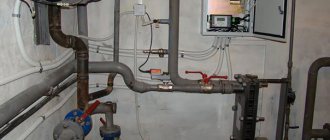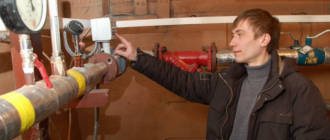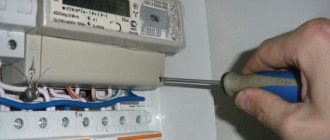How residents without meters overpay for heat
Payment for heat in houses where a common house heat meter is not installed is not based on the amount of heat that is used, but according to design (calculated) data.
The design data, as a rule, includes the maximum heat consumption for a particular house.
The actual heat consumption is almost always lower than the design (maximum) consumption.
The only exceptions are very old and dilapidated houses with worn-out communications, houses with thin walls and no insulation.
Thus, residents who live in houses without communal meters pay the maximum.
From our practice, actual heat consumption is approximately 2 - 2.5 times lower than the design one.
Paying twice as much for heat is a lot.
But that is not all.
In the networks through which heat enters your home, various types of losses occur.
Regulatory losses
Part of the heat loss is planned (standard) losses.
The heat that travels through long pipes to your home is somehow cooled slightly.
This is the normative – “normal” heat loss.
Everyone pays for these losses - residents of houses with and without communal meters.
The second part of heat loss is not standard (not planned).
Abnormal losses
Abnormal losses, as a rule, arise due to the fault of the heat supply organization.
Abnormal losses
Reason for abnormal losses:
- worn or missing pipe insulation,
- pipe breaks,
- wear,
- outdated equipment,
- failures,
- lack of network setup and
other “jambs” of heat supply organizations.
Heat supply organizations cannot accurately track the causes, location and amount of losses in networks.
Therefore, all abnormal heat losses are passed on to residents of houses without communal meters.
Another problem that arises in houses without communal heat meters is the quality of the coolant.
Residents of houses without communal meters pay for heat of high quality, but may receive heat of lower quality.
If, for example, the temperature of the coolant is lower than stipulated in the contract, it is impossible to prove this without a meter, so you will have to pay for everything in full.
If a building has a common heat meter installed, residents may request a recalculation of the payment for heat at a temperature lower than that stipulated in the contract.
Summarizing.
Residents in houses without communal meters overpay for three reasons:
- Payment for heat occurs according to design (maximum) consumption indicators, which, as a rule, are 2 times higher than actual ones.
- Payment for abnormal losses that occur in networks is usually transferred to houses without public meters.
- Houses without meters pay for the quality of heat under a contract, but in fact can receive heat at a lower temperature. Without a meter, this overpayment cannot be reimbursed.
“Service life and verification are different concepts”: what residents of the Republic of Tatarstan need to know about meters in 2021
Meters in houses are profitable and convenient. Why check and change them, how not to run into scammers when checking metering devices, what innovations await consumers of housing and communal services in 2021, Dmitry Romanov, executive director of the Regional Center for Public Control in the Housing and Communal Services of the Republic of Tatarstan, told Tatar-inform.
Why are counters needed?
The meters are designed to record the consumption of water, electricity, heat and gas. When installing them, homeowners incur costs that are recouped within a few months. Installing individual metering devices is beneficial, since in this case residents pay for the resources consumed by family members, and not at tariffs calculated for one person. Meters must provide protection from unauthorized intervention and exclude the possibility of resetting previously obtained measurement results and accumulated measurement information.
Heating fees account for approximately a quarter of the total utility bill. A heat meter is beneficial because it allows you to save money by paying only for the heat consumed, eliminating overpayments. Weather control units allow monthly savings on heat payments of up to 25-30 percent, in contrast to calculated tariffs. An important point is the correct choice of the type of device depending on the installation location and design features of the heating network, as well as concluding an agreement with a service organization that will monitor the technical condition of the device.
At whose expense are meters installed in apartments?
According to the Federal Law “On Energy Saving and Increasing Energy Efficiency” (No. 261-FZ), the installation of metering devices is carried out at the expense of the owners of residential premises. The document states that apartment owners were required to install water and electricity meters by July 1, 2012, and gas meters by January 1, 2015. However, there is no liability for failure to install them. The owner’s responsibilities also include ensuring the reliability of meter readings, as well as their timely metrological verification, which is also paid for by the tenant himself.
“The operation of an untested metering device is prohibited and is regarded by the energy supplier as the absence of a metering device with all the ensuing consequences for the consumer. In this case, fees are calculated according to current standards,” noted Dmitry Romanov.
If the apartment has not been privatized, then the owner of the premises is a municipality or another department that has on its balance sheet the residential building where the apartment is located. In this case, he is responsible for installing meters. People living in such apartments under social tenancy agreements do not have to pay for the installation of metering devices.
“If a new meter is installed, it will be sealed free of charge, except in cases where the sealing is repeated due to a violation of the seal or verification marks,” explained Romanov.
Service life of metering devices and verification time
In accordance with Federal Law No. 102 “On Ensuring the Uniformity of Measurements,” all measuring instruments must undergo initial verification before commissioning and periodic verification after a certain time of use of the device. Moreover, time is counted not from the moment the meter is installed, but from the date of issue. Verification period and service life are different concepts. Any device has a technical passport, which indicates its characteristics, including service life and verification period. For each meter, these values are set depending on the brand and model. Verification periods are also indicated on invoices.
The service life of the hot water meter is four years, verification during this time is carried out once. The service life of the meter is affected by high temperature, which causes an increased degree of wear.
The service life of the cold water meter is six years, and verification is carried out once.
Electricity metering devices have different service lives depending on their design. Old, mechanical, induction metering devices with disks last 8 years, they are verified at least once. More modern, electronic metering devices last twice as long; they are verified once every 16 years.
The service life of the gas meter is 12 years, and the verification interval is from 8 to 12 years.
The service life of a heating meter is set by the manufacturer and averages 12 years. Scheduled verification should be carried out at least four to six years.
Who pays for verification
Verification of metering devices is carried out at the expense of the owners of the devices. Individual metering devices installed in houses or apartments require periodic verification and competent confirmation of their suitability for further use as a metering device. The verification of metering devices is regulated by No. 102-FZ “On ensuring the uniformity of measurements”. Verification of meters is the responsibility of their owners.
Who carries out the verification
Only specialists licensed for such activities have access to individual metering devices. These are certified organizations with which management companies interact. The list of these companies must be clarified with the management company before verification in order to avoid troubles later. People need to understand that there are scammers on the market who offer their services at a lower price.
“Sometimes in practice we encounter different problems. It happens that a consumer engages a company without a certificate. Then the management company does not accept the meter data. The cost of checking a water meter is 400 rubles,” explained Romanov.
What other problems arise in practice?
Some inattentive residents do not keep track of when they need to check their metering devices. If the verification was not done on time, they receive accruals according to the standard. However, after verification, a recalculation is made. Sometimes problems arise for residents of houses and dormitories where there is no technical ability to install metering devices. If several people live in one room, then in practice it is difficult to prove who bears the greatest expenses.
“There are houses where there is no technical possibility to install heat meters. If heat was provided for three days at the end of September, then residents of houses with meters will pay for it. In houses where there is no technical possibility, the calculation will be made according to the standard - for the entire month. People have a question: why did they heat for only three days, but they have to pay for a month? Because this is specified in Resolution 354,” noted Dmitry Romanov.
Weather control units, which are installed in 60 percent of Kazan houses, help save on heating bills. In their absence, overflows often occur.
What documents are issued based on verification results?
Metering devices must be protected from unauthorized interference in their operation. Therefore, during the next inspection, the contractor has the right to install control seals and indicators of anti-magnetic seals, as well as seals and devices that allow recording facts of unauthorized interference in the operation of metering devices.
Upon completion of the work, the contractor draws up a corresponding act on the replacement or verification of the metering device. The document is drawn up in two copies and contains the following information:
1. Date, place, time of drawing up the act;
2. The circumstances in connection with which the verification was carried out and the violations identified;
3. Participants in the verification and drawing up of the report;
4. Signatures of the performer and the consumer.
All documents received as a result of replacing metering devices, as well as their technical passports and verification certificates must be preserved.
What happens if you don't check
If the management organization discovers that the meter was not checked on time, the owner will be notified of the need to replace the device. The receipt will indicate the amount calculated based on average consumption. That is, utility costs for six months are added up and divided by 6. This amount will be added to the receipt. This scheme will only work for three months. After accrual will be carried out according to the standard. This standard depends on the number of residents registered in the apartment, the utility tariff and the utility service consumption standard.
Since the owner violated the law and did not check the device on time, an increasing factor of 1.5 will be applied to the standard. In this case, the bill for a particular utility service may increase two to three times.
In what cases is a metering device considered to be out of order?
1. If the metering devices do not display measurement results;
2. Control seals or verification marks are broken;
3. There are mechanical damages to the metering devices;
4. The permissible errors in the meter readings have been exceeded;
5. The verification interval for checking metering devices has expired.
What to do if the meter fails
If the meter malfunctions, the consumer is obliged to notify the management organization about this, report the readings of the meter at the time of its failure and fix the problem - repair or replace it. This must be done within 30 days from the date of discovery of the breakdown. If dismantling of the metering device is required, then the responsible employees of the management company must be notified about this at least two working days before carrying out the specified work.
Which houses don't have meters?
1. Metering devices cannot be installed in residential premises or houses where, in accordance with the design conditions, it is impossible to install the device without major repairs, reconstruction, or the installation of additional engineering systems is required.
2. Internal engineering networks of the house are located in a vertical plane.
3. When installed in such premises, the metrological requirements of water meters will be violated, as well as the requirements for the procedure and location of installation in accordance with current standards.
4. The place where the water meter is attached will not allow it to be repaired or replaced.
5. In this location it is impossible to comply with the requirements for the operation of the meter, determined by the law on the uniformity of measurements. That is, the operation of the measuring device will be disrupted, as a result of which the meter will show false data. This can happen for several reasons: in case of flooding of the room, magnetic radiation, if it is impossible to take readings, or a violation of the temperature regime.
In the case of the specified technical characteristics of the premises, it is impossible to install not only individual meters in residential apartments, but also general building meters.
How to confirm the impossibility of installing a meter
A resident of a house has the right to demand from his management company to draw up a report stating that it is impossible to install meters for water, gas, electricity, as well as communal meters. This is necessary and important to do. If there is such a document, then a multiplying factor will not be applied when calculating utility fees.
The act on the impossibility of installing a meter will help reduce the amount of payment for the resource consumed. The calculation of the fee will look like the product of the consumption standard and the tariff, but without using a multiplying factor. This document can be drawn up only if there are certain criteria, the list of which is approved by order of the Ministry of Regional Development of the Russian Federation.
Who hasn't installed meters yet?
According to Dmitry Romanov, it is very difficult to name the exact number of residents of Tatarstan who have not yet installed meters. Most people have installed individual metering devices, because otherwise their utility costs would be noticeably higher.
“Today it is not economically profitable not to install meters in apartments, since there is an increasing factor of up to 1.5 percent. If the tenant does not install them, he will be punished with a ruble,” noted the interlocutor of Tatar-inform.
Installation of smart meters
From July 1, 2021, new “smart” metering devices will be installed in private and apartment buildings in our country as old electricity meters break down. Such meters will monitor how much electricity people use. The devices will transmit this data remotely to the company. If a consumer regularly delays payment, then the supply of electricity to him will be limited. The new mechanism will make it possible to shift responsibility for non-payment of bills to the direct violator, rather than spreading the amount of someone else’s debt across all consumers through the tariff. The law, which introduces in Russia the concept of “intelligent electricity metering system” and the obligation of the resource supplier to provide consumers with new generation metering devices, was adopted by the State Duma at the end of 2021 and approved by the Federation Council.
“I regard the innovation as positive. Its advantages lie in remote data transfer. People will no longer need to go to the Criminal Code or submit testimony on paper, putting them in special boxes. All this is done for the convenience of people,” says Dmitry Romanov.
The federal law is called “On Amendments to Certain Legislative Acts of the Russian Federation in Connection with the Development of Electric Energy (Power) Metering Systems in the Russian Federation.” Now citizens must purchase, install the meter themselves and be responsible for its operation. As noted in the Ministry of Construction of the Republic of Tatarstan, this innovation in Tatarstan will be supervised by network organizations or guaranteeing suppliers.
It follows from the document that “smart” meters with remote access will allow consumers to monitor online the volume of supplied energy resources and the level of their consumption. Citizens will be able to take readings via a computer or telephone, and inspectors will not have to enter each room. Individual defaulters will be able to remotely limit their energy consumption, rather than spreading the risks across all consumers, as is the case now.
The existing accounting systems are still in place, but they will be prohibited from modernizing them. When replacing meters, as well as when commissioning apartment buildings, metering devices must be installed with the ability to access the intelligent system. From January 1, 2023, guaranteeing providers and network organizations may be fined for violations in providing access.
Cost of installing a common house heat meter
The cost of installing a common house meter is about 180 - 250 thousand rubles.
Here's how that cost works out:
- Development and approval of the project - 50 thousand rubles
- Heat meter – 60 thousand rubles
- Flow meters, sensors – 40 thousand rubles
- Auxiliary materials – 10 thousand rubles
- Installation – 80 thousand rubles
- Commissioning - 10 thousand rubles
When planning the installation of a heat meter, it is necessary to take into account all costs: design, equipment, materials, installation, repairs, reconstruction of the facility.
The higher the heat consumption (calculated heat load), the higher the cost of installing a common house meter.
At the same time, the larger the house, the lower the cost per square meter of living space or per apartment.
For example, the cost of installing a common house heat meter for a small house (20 apartments) is 200 thousand rubles.
Accordingly, the cost for one apartment is 10 thousand rubles.
The cost of installing a heat meter for a large house (50 apartments) is 300 thousand rubles.
And for one apartment - 6 thousand rubles.
It follows from this that the larger the size of the house, the more profitable it is to install a common house heat meter and the faster it will pay off.
Thus, we smoothly move on to the next important topic - who should pay for the installation of a common house meter?
All requirements regarding meters are established in Federal Law No. 261 on energy saving, so let's look at the main sections of this law.
Why are heat meters needed?
Thermal energy metering devices installed in an apartment building allow you to accurately measure the amount of heat consumed by residents over a certain period of time. Usually this is a month.
The calculations are based on the difference in water temperature in the supply and return pipelines, which is used for heating apartments and common areas of the house.
Until recently, such devices were not installed, and the tariff for payment for heat was calculated based on a theoretical energy indicator, measured in gigacalories per square meter of housing area.
This indicator should be adjusted depending on the ambient temperature, the materials used in the construction of the house, and the type of structure.
In addition, the standard includes losses that inevitably occur during coolant transportation. They make up 20-30 percent of the cost. Despite the fact that everyone considers such tariffs to be significantly inflated, nothing can be done without installing metering devices.
In addition, the temperature of the radiators does not stand up to criticism. Consumers are forced to pay for cold batteries.
Important! Therefore, the state was forced to initiate the installation of communal heat meters. For this purpose, an increasing coefficient is applied to those consumers who are delaying the installation of meters.
As practice shows, in those houses where heat meters were installed, heating bills decreased by a quarter.
Who should pay for the installation of communal meters?
In accordance with Federal Law No. 261 “On Energy Saving”, residents (owners of apartments and premises) must pay for the installation of a common building heat meter.
The common house heat meter had to be installed by mid-2012.
Here is an excerpt from Federal Law No. 261. Article 13. Part 5.
Until July 1, 2012, owners of residential buildings, with the exception of those specified in Part 6 of this article, owners of premises in apartment buildings put into operation on the date of entry into force of this Federal Law, are obliged to ensure that such buildings are equipped with meters for metering the thermal energy used, as well as installed metering devices into operation. At the same time, apartment buildings within the specified period must be equipped with collective (common building) metering devices for used thermal energy.
Federal Law No. 261. Article 13. Part 6.
Until July 1, 2012, owners of residential buildings, country houses or garden houses put into operation on the date of entry into force of this Federal Law, which are united by common networks of engineering and technical support belonging to them or organizations (associations) created by them, connected to district heating systems, are obliged to ensure the installation of collective (on the border with centralized systems) metering devices for used thermal energy, as well as the commissioning of installed metering devices.
If the meter is not installed, then the heat supply organization can independently install a common house heat meter and include installation costs in the heat supply bills.
The decision to install a common house heat meter must be made at a general meeting of homeowners.
Electricity meter service life
Meters for electrical appliances are of electronic and mechanical types. Equipment installation is carried out by a qualified specialist. After the electricity meter has been installed, the specialist seals the device, indicates the date and time of putting the meter into operation, as well as the period for the scheduled inspection. Each type of meter has its own operating period, which is indicated in the technical passport and is 23-32 years. Scheduled verification averages 2 years for mechanical meters, 5-15 years for electronic ones. The electric meter has a warranty of at least 2 years.
In what cases is it necessary to replace the device:
the seal is broken or torn;
cracks, chips and other damage;
the period of operation has ended;
The electric meter did not pass the scheduled inspection.
Upon expiration of the equipment's service life, the homeowner must notify the management company and energy sales in writing. The electric meter will be replaced within a few weeks. The purchase of an electric meter is made by homeowners at their expense. Most consumers have recently preferred to switch to electronic meters, since this type of equipment has higher calculation accuracy.
Mechanical counter models:
Ekf 10103Р - Initial inspection after sixteen years. The service life of the light meter is 30 years. Four year warranty.
Mercury 201.5 - the service life of the electricity meter is thirty years. Three year warranty.
Mercury-201.7 - 3 year warranty. The service life of the Mercury counter is 23030 years.
MERCURY 230 AM 01-Service life thirty years. Warranty period 3 years.
Taypit Neva 101 1s0 - Service life 32 years.
Electronic models of metering devices:
MERCURY 201.8- Service life thirty years. The warranty period is three years.
Mercury 201 - Service life 30 years. 3 year warranty.
Mercury 200.02 - Service life 30 years. The warranty period is 36 months.
Energy meter CE 102 S7 - 5 year warranty. Service life 32 years.
Who is required to install public meters?
In accordance with Federal Law No. 261. Article 13. Section 4 owners of buildings, houses, apartments were required to install communal meters before the beginning of 2011.
Before January 1, 2011, owners of buildings, structures, structures and other facilities that were put into operation on the day this Federal Law came into force and in the operation of which energy resources are used, are required to complete equipping such facilities with meters for metering the thermal energy used, as well as introducing installed metering devices into operation.
In accordance with Federal Law No. 261. Article 13. Section 3, the requirement to install heat meters also applies to all government organizations.
Until January 1, 2011, state authorities and local governments ensure the completion of measures to equip buildings, structures, structures used to house these bodies, which are in state or municipal ownership and put into operation on the day this Federal Law comes into force, with devices metering of used thermal energy, as well as putting installed metering devices into operation.
Service life of gas meters
The service life of a gas meter is on average 20 years, and the start of operation is calculated from the date of production. A scheduled inspection is carried out every 8-12 years, depending on the manufacturer and the general characteristics of the equipment. The inspection is carried out by the gas service.
Models of domestic gas meters:
SGK - gas meter service life is 20 years. Initial inspection after 10 years.
NPM G4 - the service life of the gas meter is twenty years. The warranty period is three years.
SGMN 1 g6 - Guaranteed service life of twenty years. Scheduled verification after 96 months.
SGB g4 - Service life twenty years. Initial verification after ten years.
Betar - The service life of a Betar gas meter is twelve years. There is no verification.
IS. 161722 Grand - Warranty period 12 years.
At which objects it is not necessary to install a common house heat meter?
In Federal Law No. 261. Article 13. Section 1 you can find out which objects do not need to install meters:
The requirements of this article regarding the organization of accounting of energy resources used do not apply to dilapidated, emergency facilities, facilities subject to demolition, as well as facilities whose maximum thermal energy consumption is less than two tenths of a gigacalorie per hour.
Energy service contract as a way to avoid paying for meter installation
A common house heat meter can be installed free of charge.
Here's how it works.
The energy service company enters into a contract with the HOA or management company, installs a common house heat meter at its own expense and leases it to the home owners.
The owners pay for thermal energy according to the meter + 80% of the savings that were achieved after installing the meter.
Thus, residents of the house do not have to look for money to install a meter.
The installation is paid for by the energy service company.
The savings that are obtained after installing a common building meter are divided between the owners of the apartment building and the energy service company.
After the energy service company has returned the initial investment with a small profit, the meter becomes the property of the residents.
All savings go into the pockets of home owners.
Let's look at an example.
The cost of paying for heat before installing a common house meter was 500 thousand rubles.
Heat costs after installing the meter amount to 450 thousand rubles.
Saving 50 thousand rubles per month.
The energy service company takes 80% of the savings to cover the cost of installing the meter - 40 thousand rubles.
Initial investment - 300 thousand rubles
The planned profit of the energy service company is 100 thousand rubles
In total, the energy service company should receive 400 thousand rubles.
From here:
400 thousand / 40 thousand = 10 months
It takes 10 months to fully pay for the installation of a communal meter.
After the costs of installing the meter are covered (in our example, 10 months), the meter becomes the property of the residents of the apartment building.
Owners begin to receive the full amount of savings that arose from installing a common house heat meter (in our example, 40 thousand rubles per month).
Thus, with the help of an energy service contract, you can install a common house heat meter for free, quickly pay for its installation and reduce heating costs.
General and individual heat meters
Depending on the purpose, the metering device is installed:
- on the inlet manifold for supplying coolant to a multi-storey residential building. This ensures that the heat received by all apartments is taken into account;
- on separate pipes that lead to a specific apartment.
The industry produces counters of different types. Each consumer chooses the one that, in his opinion, is the best.
It can be:
- mechanical;
- ultrasonic;
- vortex;
- electromagnetic.
If ultrasonic ones are used by individual consumers, then all others can be installed both in the entire house and in a separate apartment.
A common house metering device is installed on the supply main line running in the basement. After the meter, heat is supplied to the apartments.
Remember! The readings on the meter are displayed in gigacalories. On a certain date, usually the last days of the month, current readings are taken. Then the difference with previous readings is calculated.
The resulting number is multiplied by the tariff approved by the government agency. The result will be the amount that must be paid to the entire house. Then, depending on the area of the apartments, the amount is distributed to each payer.
Thus, apartment owners pay for heating:
- your apartment;
- landings;
- basements and attics;
- common areas.
What you need to know before installing a communal heat meter
Before buying and installing a common house heat meter, you need to figure out which meter is best for you.
We advise you to pay attention to the following characteristics of the meters:
- meter price,
- installation cost,
- reliability,
- ease of maintenance,
- specifications.
There are 4 types of heat meters:
- Mechanical counters
- Ultrasonic meters
- Electromagnetic meters
- Vortex counters
Next, we will briefly describe the main pros and cons of all types of meters, and also advise for which buildings this or that type of meter is suitable.
Mechanical heat meters
A mechanical communal heat meter is suitable for a small house with low heat consumption.
Mechanical meters are easy to maintain and environmentally friendly.
This is the most budget option.
A mechanical meter is suitable for the private sector or a small apartment building.
Along with the meter, it is necessary to install a filter that will purify the water from impurities, iron particles, and scale.
If the water is dirty enough, the filter will need to be changed frequently.
We need to keep an eye on this.
If the filter becomes clogged, the pressure of hot water and heat may be reduced several times.
Ultrasonic heat meters
Ultrasonic meters can only be installed in new houses, with new systems and communications.
The operating principle of an ultrasonic meter is based on the passage of an ultrasonic signal through water.
Water must be free of impurities and foreign particles.
Pipelines must be free of deposits and rust.
Under other conditions, the ultrasonic meter will not work correctly, malfunction and increase heat consumption.
Due to the high sensitivity and poor quality of water in our pipelines, ultrasonic heat meters fail more often than others.
Electromagnetic communal heat meter
Electromagnetic meters require high-quality maintenance and installation,
Maintenance and installation are very important, since the operating principle of an electromagnetic meter is based on measuring small currents that arise when a liquid passes through a magnetic field.
Without long-term care, the electromagnetic meter becomes coated inside, which significantly distorts and inflates heat consumption indicators.
It is also important that the water is free of iron impurities and particles, otherwise the readings of the electromagnetic meter may be distorted.
Despite some disadvantages, an electromagnetic meter is one of the best options for buildings and apartment buildings with high heat consumption.
Vortex thermal energy meters
Vortex counters are also quite popular.
To install a vortex counter, a straight section of pipe is required.
The pipe section can be vertical or horizontal.
The operating principle of a vortex counter is based on measuring the vortices that arise after water passes through an obstacle.
In front of the vortex counter, it is necessary to install a filter that will purify the water from impurities.
After purifying the water, the meter will keep fairly high-quality and accurate records.
A vortex general house heat meter is sensitive to dirt and impurities in water, but less sensitive to iron.
Iron particles have virtually no effect on the vortex counter.
How to register a device
If a specialized organization is engaged in the installation of heat metering devices, then they independently:
- carry out design work;
- coordinate all issues with the heat supply organization;
- install a meter;
- will test its performance;
- register it with the heat supplier;
- the metering unit will be put into operation.
If the HOA deals with these issues on its own, it will take a long time.
Purchase and installation of a common house heat meter
Before purchasing, we recommend contacting a company that specializes in installation and maintenance of meters.
Specialists can do better
- assess all the technical requirements of your building,
- select and recommend the optimal meter,
- develop a project, install a common house heat meter, and in the future, possibly service it.
How to install a common house heat meter and reduce heating costs
The meter itself does not save heat.
It only correctly calculates the heat consumption of your home.
If you have a more or less new house (no older than 15-20 years), congratulations, immediately after installing a common house heat meter you will pay less.
If the house is not new, the meter will not only not reduce your costs, but may also increase your heating energy costs.
Therefore, we recommend:
- Carry out an energy audit of the building and heating system,
- Fix all problems and leaks identified during the energy audit.
- Additional insulation of the building.
You need to start with an energy survey.
An energy inspection will help you identify all problems and leaks, and focus your attention and finances on eliminating them.
After the most pressing problems have been eliminated, it is time to insulate your building.
Old buildings, especially those built during Soviet times, lose a lot of heat.
In Soviet times, no one worried about energy efficiency.
There were many cheap resources.
It was possible to heat the street.
Now gas, coal and, as a result, thermal energy are expensive.
That's why,
- additional insulation,
- high-quality thermal insulation of roofs, walls, attics,
- energy saving windows,
will help you significantly reduce your heat consumption.
The cost of a heat meter in MKD
Prices for a heat meter for the entire house are within 150,000 rubles. In addition, its installation will require additional costs. However, as practice shows, it will recoup the cost of its acquisition in three years if the cost of heating is reduced by three percent.
When insulating the external walls of an apartment building, the effect of installing a heat meter will be even greater.
In general, installing a meter at home is beneficial. However, not all residents will approve of such a decision. Indeed, in some multi-storey buildings, heat is distributed unevenly.
Apartment owners whose radiators get a little warm are more likely to negatively perceive information about the cost of a heating meter.
The way out of this situation will be simultaneous work on installing a meter and improving the distribution of heating pipes. Work must be carried out in agreement with the management company or the HOA board.
The heat supplier must accept the installed meter and seal it. Thus, the meter itself and the procedure for paying for heat will be legalized.
Service life and verification of communal heat meters
The service life of a heat meter ranges from 10 to 14 years.
Interverification interval is 4 years.
We recommend regularly diagnosing, servicing and checking your common house heat meter.
Without regular maintenance and verification, the meter will not work correctly, the data may be distorted, usually upward, and you will overpay for heat.
Water meter service life
The following factors can affect the proper operation of the water meter:
poorly purified, hard water;
rusty, worn out water supply pipes;
chips, cracks and other damage to the device;
Due to water supply problems, the meter mechanisms dry out.
Therefore, it is recommended to check equipment for hot water every 4-5 years, for cold water every 6-7 years. It is carried out at the request of the owners at their expense.
The service life of water meters before metering verification according to GOST standards is twelve years. The guarantee from the water meter manufacturer, determined by GOST, is at least one and a half years.
Installation of the counter can be done independently or with the help of an invited specialist. After installation, you must invite a specialist from the water utility who will check the installed device and seal it. According to the law, it is produced free of charge.
Sometimes an unscheduled check and replacement of the meter is required. This happens for the following reasons:
damage to the impeller of the device;
the desire of the owners to replace the old device with a new one;
loss of meter documents.
When replacing the device, you must write an application for sealing to the Gorvodokanal.
Models of water supply meters that are in greatest demand:
GERRIDA SVK - 15 G - universal metering device. The service life of individual metering devices is 12 years.
METER SV-20 is a metering device. The service life of cold and hot water meters is 12 years. Scheduled verification after 6 years.
ZENNER is a universal counter. The service life of water metering devices is 12 years.
ITELMA WFW24 D080 - hot water meter. The service life of the water meter is 12 years.
METER VK 25GI is a metering device. The service life of the hot water meter is 12 years.
Gerrida SVK-15 g - equipment for measuring mountains. water. Service life is twelve years.
WFW.20 D110 Itelma - mountain metering device. water.
WFW 23L Itelma is a cold water meter. Scheduled verification in six years.
Let's sum it up
- A common house heat meter can significantly reduce your heating costs.
- In large and new buildings, a common building heat meter pays for itself faster than in small and old buildings.
- In accordance with Federal Law No. 261 “On Energy Saving”, a common house heat meter must be installed in almost all houses and buildings.
- Concluding an energy service contract will help you install a heat energy meter for free.
- Before installing a common house meter, you need to figure out which meter is best for you.
- The heat meter must be regularly maintained and checked, otherwise you risk overpaying for heat.
Heat meters according to the law of the Russian Federation
According to the requirements of Federal Law No. 261, heat meters must be installed in all multi-apartment residential buildings.
Please note! One meter is installed per house at the expense of the condominium association. In addition, every homeowner has the right to install a similar device in his apartment, if technical conditions allow.
The methodology for calculating heating payments is regulated by Government Decree No. 354.
The main requirements of these legislative and regulatory acts are as follows:
- if the condominium has not installed a heat meter in its home, which is supplied by the utility company, then an increasing factor of 1.5 is applied to calculate the cost of the service provided;
- the meter can be installed in the apartment. This is not mandatory, but it is not prohibited either;
- Accounting using apartment meters is carried out if all apartments in the building are equipped with such metering devices. In this case, there should be a common house heat meter at the entrance to the house;
- The heat meter installed in the apartment is commissioned by the service provider, serviced by its specialists, and the costs are borne by the owner of the apartment.
Is it possible not to pay for heating if you do not live in an apartment?
At whose expense the heating batteries in the apartment are replaced, read here.
Where you can complain about the management company, read the link:
These requirements are valid as of January 1, 2018. They may change in the future, about which additional information will be posted on the website.
Attention! Our qualified lawyers will assist you free of charge and around the clock on any issues. Find out more here.










